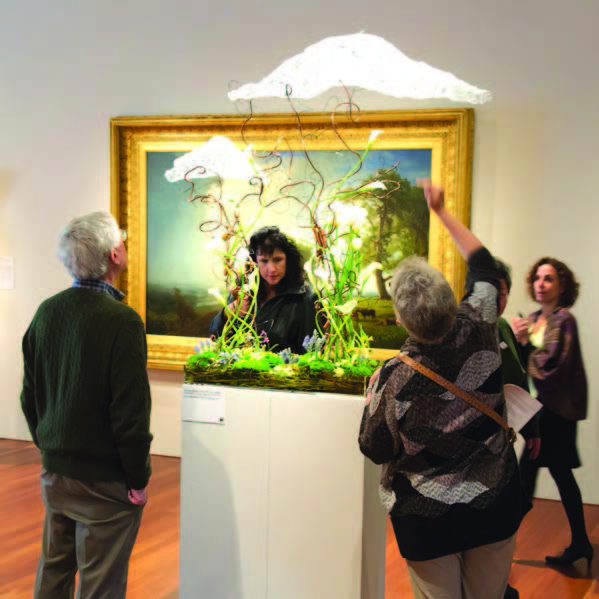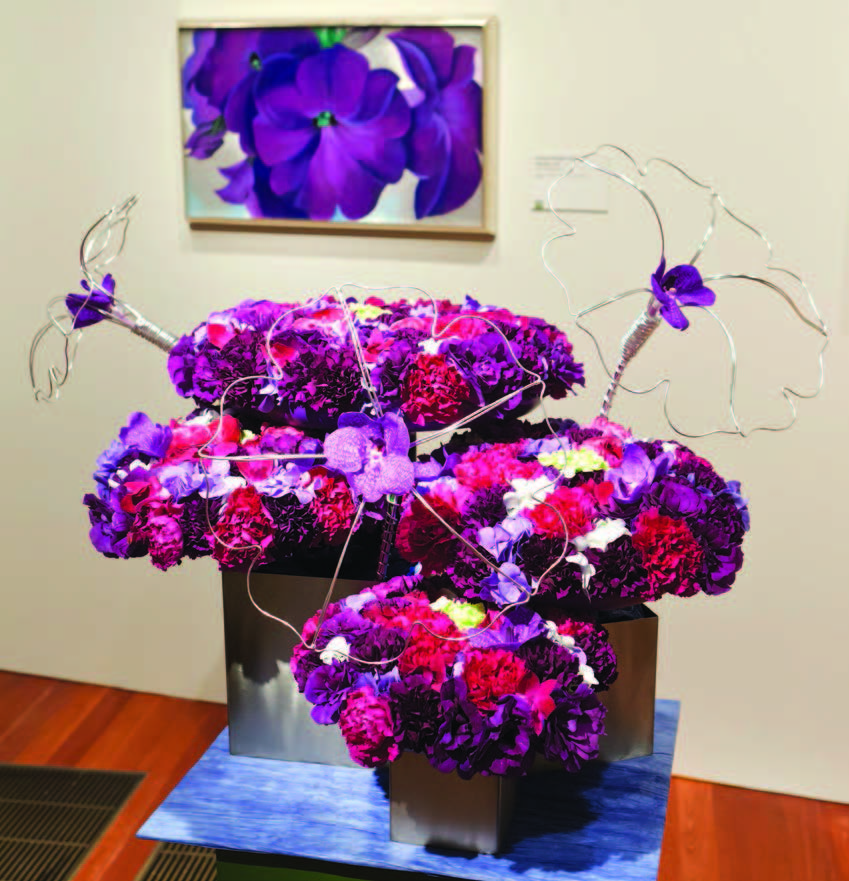This year’s Bouquets to Art coincides with the O’Keeffe exhibition, creating a perfect match. For Bouquets to Art, gifted floral designers bring their imaginative interpretations to works in the de Young’s permanent collection. Whether quirky, stunning, or simply beautiful, the designs are always captivating. This year marks 30 years of Bouquets to Art, which we highly recommend. Check it out soon because, like spring flowers, it won’t last long. The last day of the week-long event is March 23.
Q&A with Timothy Anglin Burgard, Ednah Root Curator in Charge of American Art, Fine Arts Museums of San Francisco

Michael Daigian Design & Jennifer Lato installation for 2013 Bouquets to Art at the de Young Museum, San Francisco. Photograph © Greg A. Lato / latoga photography

Georgia O’Keeffe, Petunias, 1925. Oil on hardboard. Fine Arts Museums of San Francisco, museum purchase, gift of the M. H. de Young Family. © Georgia O’Keeffe Museum. Floraldesign by Sunshine Flowers and Event Design. Photograph © Greg A. Lato / latoga photography
Many art lovers associate Georgia O’Keeffe with the Southwest, yet the focal point of the de Young exhibition is Lake George, in upstate New York. How did O’Keeffe become associated with this area?
The stunning natural topography of Lake George served as a source of inspiration for American artists from the 19th century onward. Following the Civil War, as the railroad made the region readily accessible from major urban centers, Lake George attracted numerous tourists, including the father of Alfred Stieglitz, who acquired property on the lake in the 1880s.
Georgia O’Keeffe first visited Lake George in 1908, after winning a scholarship from the Art Students League in New York that allowed her to attend a summer retreat there. In 1918, soon after commencing a personal and professional relationship with Alfred Stieglitz, she returned to the lake, and from then until 1934 spent part of each year at his family’s estate.
What kinds of works did O’Keeffe create at Lake George?
Working in her Lake George studio, which she nicknamed the “shanty,” O’Keeffe created more than two hundred works—including images of landscapes, trees, leaves, flowers, fruit, and architecture—that earned her both critical and popular acclaim when they were exhibited in New York City. Oscillating between representation and abstraction—often within a single series of works such as the “Jack-in-the-Pulpit” suite—the artist sought to evoke not merely the outward appearances of her subjects but also their inner natures.
Were O’Keeffe’s paintings essentially derived from precedents in nature?
O’Keeffe was concerned more with the sensory experience of what she painted than with its literal representation, pointedly stating: “Nothing is less real than realism. Details are confusing. It is only by selection, by elimination, by emphasis, that we get at the real meaning of things.” Many of her now-iconic flower paintings were created not from nature but from memory, either in her Lake George studio, or in her New York City apartment. O’Keeffe’s individual images are so convincing and compelling that we often overlook the intellectual component that is more apparent in series such as the Jack-in-the-Pulpit paintings, which progress from recognizable representation to near-abstraction.
How will this exhibition resonate with California residents or visitors to this state?
O’Keeffe’s idealized depictions of nature, perfected at Lake George, helped to promote a respect and reverence for the natural world that is shared by contemporary viewers—especially in California, home to Yosemite Valley, the Sierra Nevada, Lake Tahoe and many other natural wonders.
O’Keeffe’s complex relationship with Alfred Stieglitz is legendary. What drew them together?
O’Keeffe initially admired Stieglitz for his dual roles as both a pioneering photographer and a champion of European and American modernism. Even before their first meeting in 1916, O’Keeffe wrote, “I believe I would rather have Stieglitz like something—anything I had done—than anyone else I know.” Beginning in 1918, after Stieglitz convinced O’Keeffe to move to New York City, both artists felt that they had found a kindred spirit in one another, and their personal relationship blossomed.
How did O’Keeffe and Stieglitz grow apart?
A few years after the pair wed in 1924, the relationship suffered from the stress of Stieglitz’s subsequent affair with a much younger woman. O’Keeffe later observed: “I believe it was the work that kept me with him though I loved him as a human being.” By the early 1930s, although the two remained married, O’Keeffe began spending more time in New Mexico, and her trips to Lake George diminished. However, in 1946, soon after Stieglitz died, O’Keeffe made one final trip to Lake George—to bury her husband’s ashes beneath a tree on the shore of the lake.
How does symbolism feature in the Lake George works?
O’Keeffe may have intended certain works to serve not only as abstracted equivalents for her external experiences of nature but also as surrogates for her internal emotional states. The leaves in the heart-shaped composition titled Dark and Lavender Leaves (1931), created as the artist’s marriage was deteriorating, may reflect the relative ages of Stieglitz and O’Keeffe, who was much younger than her husband, as well as their respective roles as mentor and protégé. The small but vibrant young lavender leaf appears both protected and overshadowed by the much larger leaf, which is dark and decaying.
O’Keeffe’s iconic flower paintings are frequently subject to speculations regarding their potential symbolism. How did these interpretations originate?
When O’Keeffe commented on the origin of her flower subjects, she spoke of using her enlarged and cropped formats to compel busy New York City urban dwellers to stop and appreciate the beauty of flowers, which, like other aspects of nature, had been marginalized in an increasingly technological age. Unfortunately, Stieglitz’s scandalous 1921 exhibition of nude photographs of O’Keeffe, combined with a popular vogue for Freudian psychology, which encouraged such metaphoric readings, fostered numerous sexual interpretations of O’Keeffe’s flowers.
What was O’Keeffe’s reaction to the psychological interpretations of her flower paintings?
O’Keeffe rejected such reductive readings, stating, “I made you take time to look at what I saw, and when you took time to really notice my flower, you hung all your associations with flowers on my flower, and you write about my flower as if I think and see what you think and see—and I don’t.”
Do these interpretations have any validity or relevance?
First, to state the obvious, flowers contain the reproductive sexual organs of plants and therefore are, by definition, sexual. Like Picasso, who denied having been influenced by African art when this limiting line of questioning became annoying, O’Keeffe grew hostile to interpretations that suggested her paintings were essentially abstracted representations of human sexual organs. But O’Keeffe was rarely interested in such literal translations of form from nature to canvas. She sought to capture not merely how her subjects looked, but rather her emotional experience of them. As the French Symbolist poet Stephane Mallarme said, “describe not the object itself, but the effect it produces.” O’Keeffe’s letters strongly suggest that many of her physical and emotional experiences found lasting expression in her art.
How do you account for the fact that O’Keeffe has achieved nearly iconic status?
First and foremost, O’Keeffe’s works are exceptional examples of early American modernism. Second, O’Keeffe also earned the financial and critical support of Alfred Stieglitz, America’s most influential art arbiter in the first half of the 20th century. Third, her best-known works became nearly synonymous with a place—the American Southwest—that retains a romantic frontier aura of both historical and cultural authenticity. Fourth, feminists embraced O’Keeffe as a role model, even though she resisted being typecast as a “woman artist.” Fifth, she is one of the few American artists to have a museum devoted to preserving and promoting her work. Finally, O’Keeffe’s embrace of nature as the primary focus of her art, and her creation of idealized images that achieve a kind of platonic perfection, reaffirm our perennial ties to nature in an increasingly technological age.
Has O’Keeffe’s fame helped or hindered an appreciation of her work?
Like Andy Warhol, O’Keeffe is associated with a public persona that has threatened to obscure her artistic achievements. In part, this phenomenon may be traced to the fact that O’Keeffe was likely the most photographed artist in history. Alfred Stieglitz’s extended photographic portrait of his partner spanned two decades and numbered more than 300 photographs. Some of the earliest portraits, in which Stieglitz posed the artist in front of her artworks, commenced a process in which the artist and her works were conflated, or even seen as interchangeable.
However, as with Warhol, nearly three decades have passed since O’Keeffe’s death, in 1986—a span that enables us to perceive her artistic achievements more clearly. Modern Nature: Georgia O’Keeffe and Lake George, the first exhibition devoted to a critical period in the artist’s life and work, will play an important role not only in setting the New York and Lake George period on equal footing with the Southwest period but also in reaffirming O’Keeffe’s stature as one of the greatest American modernists.
For tickets and more information about the exhibit, please visit deyoungmuseum.org
Recent Comments